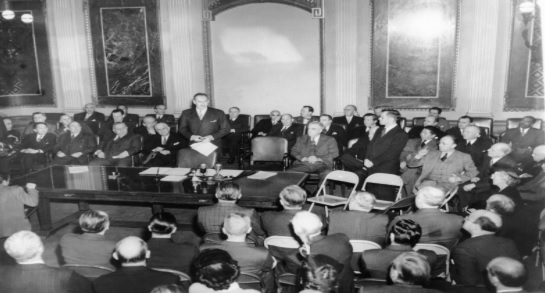
- The Bretton Woods Conference, officially known as the United Nations Monetary and Financial Conference, was held in July 1944 in Bretton Woods, New Hampshire, USA.
- Its main aim was to reconstruct and stabilize the global economic order after the devastation caused by World War II.
- Delegates from 44 allied nations came together to design a new international monetary system that would:
- Ensure economic stability
- Prevent future global financial crises like the Great Depression
- Promote free trade and cooperation among nations
Key Outcomes of the Bretton Woods Conference
Creation of Bretton Woods Institutions
- Two major institutions were established as a result of this conference:
International Monetary Fund (IMF):
- Purpose: To ensure the stability of the international monetary system.
- Functions:
- Provide short-term financial assistance to countries facing balance of payments crises
- Maintain exchange rate stability
- Promote international monetary cooperation
- Monitor global economic trends and provide economic advice.
International Bank for Reconstruction and Development (IBRD) – now part of the World Bank Group:
- Purpose: Initially to help Europe rebuild after World War II.
- Now known as the World Bank, its role evolved to:
- Provide long-term loans and development aid to developing and underdeveloped countries
- Encourage sustainable economic development
- Support infrastructure projects, education, healthcare, and poverty reduction
Establishment of a Fixed Exchange Rate System
- The Bretton Woods system introduced a fixed exchange rate regime, where:
- Countries agreed to peg (fix) the value of their currencies to the US Dollar, and
- The US Dollar was convertible to gold at $35 per ounce
Why this system?
- It was designed to provide currency stability, avoid competitive devaluations, and encourage international trade and investment.
However:
- The system came under pressure in the 1960s due to:
- Rising US inflation
- Trade deficits
- Increasing demand for gold
- In 1971, US President Richard Nixon suspended the convertibility of the dollar into gold, effectively ending the Bretton Woods gold standard.
- By 1973, the system collapsed and countries shifted to a floating exchange rate system, where currency values are determined by market forces.
Promotion of Free Trade and Economic Cooperation
- One of the key philosophical goals of the Bretton Woods Conference was to promote global economic prosperity and peace by encouraging free and fair trade.
- This led to the creation of multilateral trade agreements and eventually the formation of the:
- General Agreement on Tariffs and Trade (GATT) in 1947
- World Trade Organization (WTO) in 1995
Legacy and Significance
- The Bretton Woods Conference laid the foundation of the modern global economic system.
- It promoted global financial stability, economic cooperation, and international development.
- Institutions like the IMF and World Bank continue to play crucial roles in:
- Providing loans and policy advice to countries in crisis
- Supporting sustainable development goals
- Facilitating global economic integration



